
| ||||
Presentation
|
|
|
An ironworks was founded on the River Fiskars some 350 years ago, when Finland was still part of the Kingdom of Sweden. Fiskars is located in South Finland, almost 100 kilometers west of Helsinki. The blast furnace and forge of the works were powered by the river, and charcoal essential for the operation of the works was obtained from the surrounding forests that still cover extensive parts of the surrounding region.
The copper smith's workshop built on the lower rapids in 1818
and some of its workers, in a photogrph from the 1860s.  Today, Fiskars is one of the oldest industrial enterprises still in operation in the Western Hemisphere and iron and steel still feature among its products, of which the best-known ones are scissors and gardening tools. The vitality of the corporation is demonstrated by its role as a leading international manufacturer of scissors. Along with internationalization, Fiskars has expanded production into many countries, and as a result the old, outmoded facilities at the ironworks were vacated. But in the 1980s the closing of industrial operations at Fiskars also meant a decrease in the local population, with the result that houses lost their inhabitants and shops were closed, and even the local primary school was in danger of closure.
Today, Fiskars is one of the oldest industrial enterprises still in operation in the Western Hemisphere and iron and steel still feature among its products, of which the best-known ones are scissors and gardening tools. The vitality of the corporation is demonstrated by its role as a leading international manufacturer of scissors. Along with internationalization, Fiskars has expanded production into many countries, and as a result the old, outmoded facilities at the ironworks were vacated. But in the 1980s the closing of industrial operations at Fiskars also meant a decrease in the local population, with the result that houses lost their inhabitants and shops were closed, and even the local primary school was in danger of closure.
Glass vase by Camilla Moberg 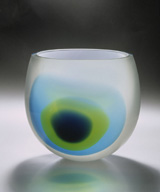 These developments, however, came to a turning point in 1993, when a four-member team consisting of Barbro Kulvik, Antti Siltavuori, Timo Vesara and Kari Virtanen, launched exhibition activities related to design and applied arts at Fiskars. The Fiskars corporation gave the exhibition organizers the use of the former Copper Workshop, a factory building dating from the 18th century. These developments, however, came to a turning point in 1993, when a four-member team consisting of Barbro Kulvik, Antti Siltavuori, Timo Vesara and Kari Virtanen, launched exhibition activities related to design and applied arts at Fiskars. The Fiskars corporation gave the exhibition organizers the use of the former Copper Workshop, a factory building dating from the 18th century.
Now, at the beginning of the new millennium, Fiskars is a place of light and life, with new residents and constantly improving services. In only a few years, summer exhibitions among the best Finland has to offer have become an established tradition.
Ceramic plates by Anneli Sainio  The historic ironworks is the home and workplace of an internationally unique community of craftspersons, designers and artists. But in spite of a new wave of activity, Fiskars has maintained its cultural values and unique character. The ironworks today is anything but an outdoor museum. The historic ironworks is the home and workplace of an internationally unique community of craftspersons, designers and artists. But in spite of a new wave of activity, Fiskars has maintained its cultural values and unique character. The ironworks today is anything but an outdoor museum.
The impressive two storey mill by the middle
rapids is made of slag bricks in 1898.  The craftspersons, designers and artists who have moved into the heritage site of the ironworks village have played a key role in the revitalization that has taken place in the past few years and in the creation of new jobs. For example in the old workshop of the ironworks there is now a woodworking plant using special types of wood - 29 different species of trees grow on the hill slopes at Fiskars. In keeping with old craft customs, the workshop employs not only skilled carpenters and joiners but also trainees, apprentices. An old masonry cowshed that stood unused for many years is now the site of a candle factory. A plant building of the early 1970s now houses a spacious artistユs studio, a glassblowing workshop and a workshop where wooden boats are made. The village also has a design office, an interior design bureau, a smithy, several ceramics workshops, and a small-scale papermaking studio. The craftspersons, designers and artists who have moved into the heritage site of the ironworks village have played a key role in the revitalization that has taken place in the past few years and in the creation of new jobs. For example in the old workshop of the ironworks there is now a woodworking plant using special types of wood - 29 different species of trees grow on the hill slopes at Fiskars. In keeping with old craft customs, the workshop employs not only skilled carpenters and joiners but also trainees, apprentices. An old masonry cowshed that stood unused for many years is now the site of a candle factory. A plant building of the early 1970s now houses a spacious artistユs studio, a glassblowing workshop and a workshop where wooden boats are made. The village also has a design office, an interior design bureau, a smithy, several ceramics workshops, and a small-scale papermaking studio.
Hand built stoneware vases by Erna Aaltonen
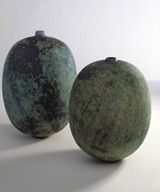 The first exhibition of the craftspersons, designers and artists of Fiskars in the summer of 1994 had far-reaching results. This showing forged its participants into a community. The reputation of the new Fiskars began to spread from the old copper workshop to the outside world. Many of the items exhibited there have since then become classics. Visitors were amazed that a community of a mere 500 people and thirty or so exhibitors could stage such an impressive event.
The first exhibition of the craftspersons, designers and artists of Fiskars in the summer of 1994 had far-reaching results. This showing forged its participants into a community. The reputation of the new Fiskars began to spread from the old copper workshop to the outside world. Many of the items exhibited there have since then become classics. Visitors were amazed that a community of a mere 500 people and thirty or so exhibitors could stage such an impressive event.
The old granary now serve as exhibition
facilities with plenty of space and light 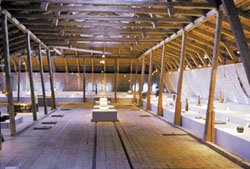 This community has since then grown and organized itself as a cooperative, with over 90 members at present. In 1999 this continually growing community included an artisan, a restorer, an enamel artist, a designer of objects, a silversmith, a ceramist, a bookseller, a jeweller, a weaver, a visual artist, a glassblower, a microbiologist specializing in flax, a maker of traditional Finnish sheath knives, a cabinetmaker, a smith, an interior architect, an instrument-maker, an artist-photographer, a graphic artist, a textile artist, an industrial designer and a boat-builder. This community has since then grown and organized itself as a cooperative, with over 90 members at present. In 1999 this continually growing community included an artisan, a restorer, an enamel artist, a designer of objects, a silversmith, a ceramist, a bookseller, a jeweller, a weaver, a visual artist, a glassblower, a microbiologist specializing in flax, a maker of traditional Finnish sheath knives, a cabinetmaker, a smith, an interior architect, an instrument-maker, an artist-photographer, a graphic artist, a textile artist, an industrial designer and a boat-builder.
The former school house and stables, with the towerclock, are a landmark in Fiskars. The permanent exhibition entitled Fiskars 1649 was opened in 1989. In addition to the history of ironworks, the exhibition features the early days of iron-making in Finland as well as Fiskars' products of today.
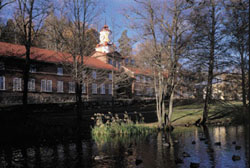 The community has held annual exhibitions since 1994. Their themes have included nature at Fiskars, natural materials, storage and preservation, dialogues, processes, and the celebration of Fiskars' jubilee year in 1999. The community has its own central office and general secretary, as well as the gallery shop Onoma in the Clock Tower, which can well be described as the distinctive landmark of Fiskars. The community has held annual exhibitions since 1994. Their themes have included nature at Fiskars, natural materials, storage and preservation, dialogues, processes, and the celebration of Fiskars' jubilee year in 1999. The community has its own central office and general secretary, as well as the gallery shop Onoma in the Clock Tower, which can well be described as the distinctive landmark of Fiskars.
Onoma, gallery shop is owned by members and there
is on sail products by local designers and craftsmen.  The shop has increased its sales every year. Fiskars can now accommodate two major summer exhibitions. The decorative granary building from the early twentieth century has been refurbished into an exhibition venue. The Fiskars community has used its good offices to put on, in addition to its own exhibitions, a National Wood Year exhibition, a major biennial of Finnish and international paper art, plus an international ceramics exhibition entitled Born in Clay featuring the work of 70 ceramists from 13 countries. The exhibitions of 2001 focused on the themes of metal and children. The shop has increased its sales every year. Fiskars can now accommodate two major summer exhibitions. The decorative granary building from the early twentieth century has been refurbished into an exhibition venue. The Fiskars community has used its good offices to put on, in addition to its own exhibitions, a National Wood Year exhibition, a major biennial of Finnish and international paper art, plus an international ceramics exhibition entitled Born in Clay featuring the work of 70 ceramists from 13 countries. The exhibitions of 2001 focused on the themes of metal and children.
Easygoing Fiskars has always had links with the rest of the world. Design offices and workshops at Fiskars make products and designs for faraway locations, such as an executive sauna for Finnish companies in Moscow, mining machinery for Canada, forestry equipment and machinery for Sweden, and furniture for Japan. The exhibits originally on show at Fiskars have often made their way abroad, for example to a design exhibition in Nice, the Barbican Centre in London, and a special exhibition put together at the Hoganas Museum in Sweden by members of the Fiskars community, which aroused a great deal of interest in it. Exhibitions have been exchanged with the Bergslagen region of Sweden, and both areas have participated in a joint showing in Brussels. All this has been achieved through extensive volunteer efforts. A special team has been selected for each exhibition project. Funding has largely been based on ticket sales or financial support specially obtained for the project at hand. The community has not received any annual support from public funds. In addition to volunteer enthusiasm, the objective has also been, since the very beginning, to ensure the high quality of exhibitions and products. Also the currently fashionable trend of networking has meant a great deal. There are joint projects and ventures in which one party design and plans, while another makes the products, and the sales are arranged in a jointly run shop, or an interior architect or designer will assemble a collection of the works and products of several people professionally active at Fiskars.
The old Copper Smith hoses large former industrial
spaces for exhibitions and for a restaurant.  But the exhibitions can be regarded as the catalyst of all work and activities at Fiskars. The high-standard showings generate publicity, which brings visitors who also become the clientele of the artists, designers and craftspersons of the community. All this has also had a positive effect on the careers of many members of the Fiskars community. At the practical level the availability of workspace and housing has also meant a great deal. The Fiskars Corporation has renovated, rented or sold buildings that have been empty or in partial use, along with lots for new buildings. But the exhibitions can be regarded as the catalyst of all work and activities at Fiskars. The high-standard showings generate publicity, which brings visitors who also become the clientele of the artists, designers and craftspersons of the community. All this has also had a positive effect on the careers of many members of the Fiskars community. At the practical level the availability of workspace and housing has also meant a great deal. The Fiskars Corporation has renovated, rented or sold buildings that have been empty or in partial use, along with lots for new buildings.
| ||
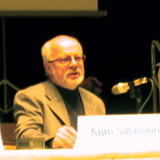 Fiskars Artist and Design Community
Fiskars Artist and Design Community